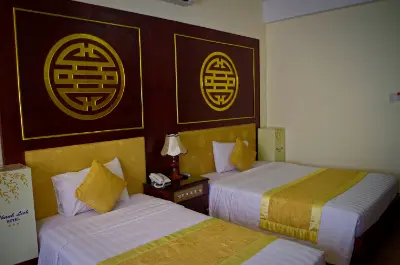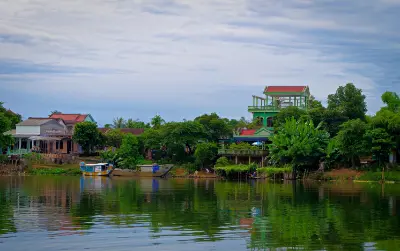Hué and the Imperial City

Welcome to Hué and the Imperial City
🏯 Huế: the city of emperors and poets
📍 Location
- Located at central Vietnam, in the province of Thừa Thiên-Huế, Huế is bordered by the Perfume River (Sông Hương) and protected by the Ngự Bình Mountain, considered a sacred screen according to the principles of feng shui.
- She was the capital of unified Vietnam of 1802 to 1945, under the Nguyễn Dynasty, the country's last imperial dynasty.
🧬 Atmosphere and identity
- Huế is a city refined, spiritual and melancholic, where we still feel the weight of the imperial past in gestures, landscapes and traditions.
- She is renowned for her court music, his delicate gastronomy, his sung poems, and its Buddhist ceremonies.
- The city is also a intellectual and religious center, with many pagodas, temples, and royal tombs scattered throughout the surrounding countryside.
🏰 The Imperial City: the beating heart of Vietnamese history
🏛️ Structure and inspiration
- Inspired by the Forbidden City of Beijing, the Imperial City (Hoàng Thành) is a vast fortified complex of more than 500 hectares, surrounded by 6-meter-high walls and a 7 km ditch.
- It comprises three nested enclosures:
- Kinh Thành : the outer citadel, housing the administrative buildings.
- Hoàng Thành : the royal city, with palaces and ceremonial places.
- Tử Cấm Thành : the Forbidden Purple City, private residence of the emperor and his family.
🌟 Iconic monuments
- South Gate (Ngọ Môn) : majestic main entrance, formerly reserved for the emperor.
- Thái Hòa Palace : throne room, decorated with dragons and imperial motifs.
- Duyệt Thị Đường Royal Theater : place of traditional shows for the court.
- Thế Tổ Miếu Temple : dedicated to the imperial ancestors.
- Residences, gardens, ponds and pavilions : bear witness to a refined and codified art of living.
🛠️ Restoration and recognition
- Severely damaged during the wars of the 20th century, the Imperial City was the subject of a extensive restoration program.
- It is classified in the UNESCO World Heritage Site Since 1993, asexceptional monumental ensemble.
✨ Why Huế and its Imperial City are unforgettable
It is a place where silence is sacred, where each stone whispers the echo of ancient ceremonies, and where elegance blends with memory. Huế is poetic, majestic and deeply Vietnamese — a city that invites contemplation, slowness and inner discovery.
See also The Mausoleum of Tu Duc
🏯 The Mausoleum of Tu Duc: between imperial solitude and Confucian refinement
📍 Location
- Located approximately 8 km southwest of Hué, in the Duong Xuan Thuong village, at the heart of a pine-wooded valley, this mausoleum is one of the largest and most romantic in the region.
🧬 Emperor Tu Duc : A Long and Melancholic Reign
- Tu Duc (Nguyen Phuc Hong Nham) was the fourth emperor of the Nguyễn Dynasty, reigning from 1847 to 1883, either the longest imperial reign of this dynasty.
- A great scholar, passionate about poetry, philosophy and arts, he was also a man fragile and lonely, marked by illness and the absence of an heir.
- He had his mausoleum built during his lifetime, between 1864 and 1867, as personal refuge, a place of retreat and meditation, long before his death.
🏛️ Architecture and atmosphere
- The complex covers nearly 20 hectares, with more than 50 structures distributed around a artificial lake, of flower gardens, of leisure pavilions, and of Confucian temples.
- Each building bears the word “Khiêm” (modesty), a reflection of the humility that the emperor wanted to embody despite the grandeur of the place.
- The site is divided into three zones :
- Temple area : with the Hoa Khiêm Palace, where Tu Duc worked and received his concubines.
- Luu Khiêm Lake Area : with pavilions on stilts, the wooded islets, and the royal embarkations.
- Funeral area : with the Khiêm stele, the stele pavilion, and the symbolic tomb (because the actual place of his burial remains unknown).
🌿 Atmosphere and experience
- The mausoleum is a haven of peace, where we hear the birdsong, the rustling of the pines, and the lapping water.
- It is a place of contemplation, where we can stroll between the pavilions, read engraved poems, or sit by the lake to feel the imperial melancholy.
- The contrast between the architectural grandeur and the softness of the landscape actually a deeply site moving and spiritual.
✨ Why the Tu Duc Mausoleum is unforgettable
It is a place where the imperial art of living mixes with the solitude of power, where each stone seems to carry a verse, and where silence becomes poetry. The Mausoleum of Tu Duc is refined, intimate and deeply Vietnamese — a masterpiece of sensitivity and elegance.
Address suggestion
Thanh Lich Hôtel 33 Hai Ba Trung | Vinh Ninh Ward, Hué 530000
Continue to Hué and the Perfume River
The Perfume River, located in Hué, Vietnam, is a majestic waterway that flows through the historic city. It gets its name from the flowers that fall into its waters as they are carried to the sea, creating an enchanting fragrance.


